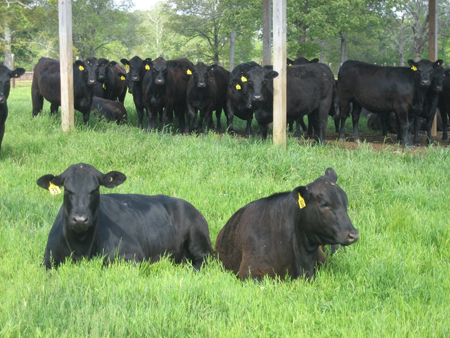
- Controlled Calving Season
- Checking for Pregnancy
- Strategic Supplementation
- Body Condition
- Heifer Development, Selection and Breeding
- Herd Health
- Dystocia
- Breeding-Soundness Examination
- Summary
Reproductive efficiency has long been recognized as the most important aspect of commercial beef production. If only 50 percent of the cows wean a calf, crossbreeding, superior genetics and sound management become insignificant.
Marked variations exist in the percent calf crop among Georgia beef cattle herds. Well-managed herds have a calf crop of more than 90 percent, while poorly managed herds may actually have less than a 75 percent calf crop. This variation in calf crop can be the difference between profit and loss.
To meet production expenses, a producer must average a calf crop of more than 85 percent.
Today, many beef cattle producers are paying for the privilege of being in the cattle business, but a few innovative operation changes could significantly improve profit potential. Improved herd management and selection for reproductive performance can substantially increase the percent calf crop.
A producer should have a goal of a 95 percent calf crop during a 60-day calving season, with a 500-pound plus average weaning weight. As shown in Table 1, percent calf crop has a great influence on the calf production per cow exposed. For example, a Georgia producer with an 85 percent calf crop would produce 425 pounds of calf per cow with a 500-pound weaning weight.
| Table 1. Pounds of Calf Produced per Cow | |||
| Percent Calf Crop | Average Weaning Weight | ||
| 600 | 500 | 400 | |
| 100 | 600 | 500 | 400 |
| 95 | 570 | 475 | 380 |
| 90 | 540 | 450 | 360 |
| 85 | 510 | 425 | 340 |
| 80 | 480 | 400 | 320 |
| 75 | 450 | 375 | 300 |
| 70 | 420 | 350 | 280 |
Table 2 illustrates the influence of calf crop and weaning weight on returns per cow. Notice that improving the calf crop percentage from 80 to 90 percent produces almost the same economic gain as increasing the weaning weight from 500 to 600 pounds. Efficient management, however, is an art and skill that requires manipulating several factors that affect net productivity. For example, a good manager could improve weaning weight from 400 to 600 pounds while also increasing the calf crop from 80 to 95 percent — the net result being an increase of $204 per cow exposed.
Reproductive management is the combination of using proven beef cattle management skills
and practical economic principles to attain the most economically efficient operation possible.
| Table 2. Dollars Returned per Cow — Oct.-Nov. 5 Year Avg.* | |||
| Percent Calf Crop</b > | Average Weaning Weight</b > | ||
| 600 | 500 | 400 | |
| 100 | $612 | $545 | $472 |
| 95 | $582 | $518 | $448 |
| 90 | $551 | $491 | $425 |
| 85 | $520 | $463 | $401 |
| 80 | $490 | $436 | $378 |
| 75 | $459 | $409 | $354 |
| 70 | $420 | $382 | $330 |
| Georgia Auction Markets – 2009-2011. *$/cwt: $102 (600 lbs.); $109 (500 lbs.); $118 (400 lbs.) |
|||
To reach this goal, the following key management areas are essential:
Controlled Calving Season
The most important management decision in a beef operation is to establish a controlled calving season.When establishing a controlled calving season, you may need to start with a 180-day breeding season at first, followed by a 120-day breeding season, then a 90-day breeding season and finally a 60-day breeding season. A 45-day breeding season may be feasible under certain management conditions. You can find a more complete description of how to initiate a controlled calving season in the University of Georgia Cooperative Extension Bulletin 1307 "Converting to a Controlled Breeding Season."
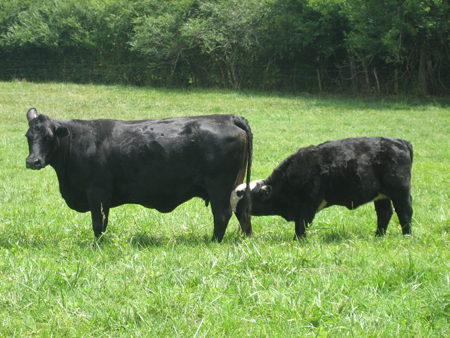
The season or time of the year that calves are born influences the calf crop percentage and should be dictated by the available forage supply, labor and market for the calves. Cows that calve about 30 to 60 days before the most abundant grass production will usually wean more calves annually than cows that calve during other seasons.
If good-quality winter grazing is available, calving during the late fall may be an alternative. Cows wintered on hay and short pasture will have better success with late winter or early spring calving. Avoid calving during the summer because the calves will weigh less at weaning. For help identifying the best calving season in your area, visit other producers and talk to your local county Extension agent (1-800-ASK-UGA1).
Checking for Pregnancy
After the end of the breeding season, examine all cows and heifers for pregnancy. Because heifers should be bred first, they can be examined earlier than cows. Pregnancy checking of heifers can be done by rectal palpation after 35 to 90 days, by ultrasound examination after 30 to 90 days, or by blood analysis after 30 days.
If more pregnant heifers are available than are needed for replacements, the heifers that became pregnant last may be sold as bred replacement heifers. A competent palpator can determine the breeding date quite accurately when cattle are 35 to 110 days into gestation.
Many producers prefer to palpate cows as the calves are weaned in the fall. Cows are also normally treated at this time for grubs, lice and internal parasites. At this time, cows should be about 150 days pregnant. Although the chance for an accurate confirmation of breeding date by palpation is lower at this time, determining pregnancy is easier for the less-experienced palpator. A blood test conducted 30 days post-breeding or 90 days post-calving can determine pregnancy but will not indicate the stage of pregnancy.
A skilled, experienced individual – usually the local large-animal veterinarian – should do the pregnancy palpation determination. Knowledge of female reproductive tract anatomy and the physiological changes associated with various stages of pregnancy are necessary to become competent at determining pregnancy status.
Failure to become pregnant accounts for about 75 percent of calf crop reductions. Open cows and heifers should be culled from the herd before the winter feeding period. Since a cow that is open at weaning time will not wean another calf for two years, this same period could be used to put a heifer calf into production. Research has shown that heifers that fail to breed the first year and are held over have an average lifetime calf crop of 55 percent, compared to 86 percent for herd mates that become pregnant the first year.
Pregnancy determination and culling all open females will increase reproductive efficiency within two or three years (Table 3).
A controlled calving season also allows the manager to take better care of both heifers and mature cows in groups since feeding efficiency can be improved when similar animals are grouped and sorted. For example, all females in a group should be at a similar stage of pregnancy or lactation and have similar nutritional requirements. Grouped animals can also be monitored closely to determine supplement needs.
| Table 3. Effect of a Controlled Calving Season and Culling Open Cows on Calving Percent and Weaning Weights | ||
| Year | Percent Pregnant | Weaning Weight (lbs) |
| 1953 | 44 | 350 |
| 1954 | 55 | 415 |
| 1955 | 82 | 432 |
| 1957 | 88 | 431 |
| 1959 | 92 | 406 |
| 1960 to 1964 | 94 | 508 |
| University of Florida -- 1973. | ||
Strategic Supplementation
A successful rebreeding program depends on many factors. Most important are the body condition of the cows and heifers at the time of calving and the feeding level after calving. Inadequate pre-calving nutrition will result in a lower body condition score plus increased number of days from calving to first heat. A reduced energy intake after calving results in a decreased conception rate at the early heats.
Inadequate nutrition will result in delayed rebreeding,
later calving dates and a decreased calf crop percentage.
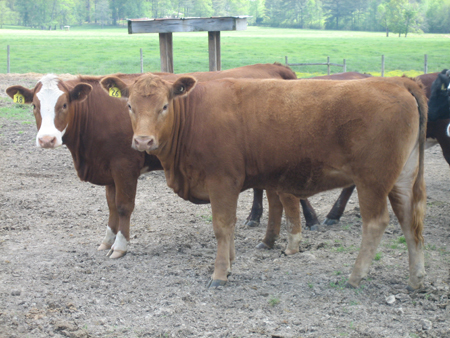
The first-calf heifer is particularly difficult to rebreed after calving. The demands of lactation and growth can cause an extended interval from calving to first heat ranging from 120 to 150 days; therefore, heifers are more likely to breed back at the same time as mature cows. If a heifer is thin at calving, she may not return to heat within the desired breeding season. Heifers should be bred two to three weeks earlier than the mature cows and sorted so they can be fed properly.
Getting first-calf heifers rebred on a yearly calving schedule is
one of the greatest challenges facing the cow-calf producer.
Body Condition
The body condition of a pre-calving cow will influence her post-calving feed needs as well as her rebreeding performance. Cows that are thin pre-calving require more feed to rebreed following calving, and cows in good body condition need to be maintained.
The influence of body condition at the time of calving on subsequent rebreeding can be seen in Table 4. These cows had calved 65 to 83 days before the beginning of the breeding season. As shown, three times as many cows in moderate body condition were pregnant after a 60-day breeding season than thin cows. The thin cows failed to become pregnant because they did not come in heat and were never serviced.
Failure to come in heat is the most common reason that first-calf heifers and thin cows fail to become pregnant.
For a more complete understanding of body condition, refer to UGA Cooperative Extension Bulletin 1308 "Body Condition Scoring Beef Cows."
Table 4. Influence of Body Condition at Calving on Pregnancy Rates
| Body condition at calving | % Pregnant after breeding for | |
|---|---|---|
| 20 days | 60 days | |
| Thin | 4 | 24 |
| Moderate | 27 | 61 |
| Good | 65 | 87 |
Heifer Development, Selection and Breeding
Development of replacement heifers is a key element in improved herd reproductive performance. The time between weaning and rebreeding is critical if you expect a high conception rate. Weight is an important factor in when a heifer reaches puberty; therefore, heifers should reach their target weight by 15 months of age for optimum reproduction. Heifers from British breeds should weigh at least 650 pounds at the beginning of the breeding season. The larger Continental breeds should weigh at least 750 pounds. Crossbred heifers tend to reach puberty at a slightly younger age and lighter weight than straight-bred heifers.
Heifers should weigh at least 65 percent of their expected mature body weight
at the beginning of the breeding season. This weight is referred to as the target weight.
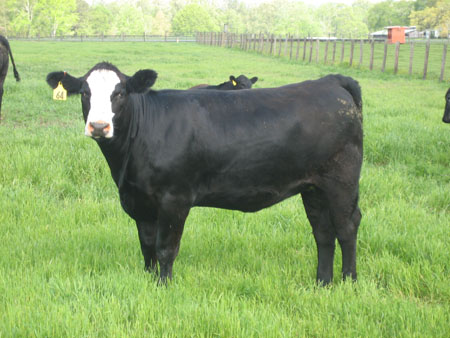
Weigh heifers so they can gain necessary weight by the target breeding date. Heifers will usually need to gain 1 1/2 to 1 3/4 pounds per day to reach their target weights. Because heifers should be bred three or four weeks before the cow herd, in most cases, they will average only 14 months of age at the beginning of the breeding season. Calculate the number of days from weaning to the start of the breeding season to determine the average daily gain needed to reach the target weight.
For example, a 500-pound Crossbred heifer weaned at 250 days needs to weigh 750 pounds at 14 months (420 days) of age to breed early. That gives her 170 days to gain the additional weight. Thus, the average daily gain to breeding would be 250 pounds (750-500) divided by 170 days, or 1 1/2 pounds per day.
Heifers selected for breeding should be born during the first half of the calving season. These heifers should be older, heavier and out of the more highly fertile cows. Consequently, they should have a better chance of reaching puberty and conceiving early. Select more heifers to breed than needed for replacements; usually 50 percent more than are needed to replace the cows culled from the herd. Breed heifers for no longer than a 65-day breeding season and sell all open heifers.
A 65-day breeding season is equal to three chances for heifers to conceive. If sufficient pregnant heifers
are available, keep only those that conceive early (in the first 30 days) as herd replacements.
Breed heifers to a bull known to sire small calves at birth. There are bulls within each breed (some more than others) that sire small, healthy calves.
During the first production cycle, the most important factor is for a heifer
to produce a live calf and breed back within the next breeding season.
Herd Health

The third and possibly most neglected aspect of reproductive management is herd health. A herd can be operating on a 60-day calving season with an ideal nutrition program and yet still be devastated by a disease outbreak or the sterility of a once-dependable bull. A total herd health program formulated by the producer and veterinarian is the best solution.
Your local large animal veterinarian is the most qualified person to outline a vaccination program that will protect against the most serious diseases. His expertise in disease diagnosis and vaccine selection is invaluable but frequently overlooked. The major diseases that can impair reproductive efficiency are Leptospirosis, Vibriosis, Brucellosis and Infectious Bovine Rhinotracheitis (IBR), and Bovine Virus Diarrhea (BVD). Vaccines for these diseases are available and prevention is a much better alternative to a reduced calf crop.
Before vaccinating, consult a veterinarian for advice on the vaccination program for a particular herd.
Other primary areas of importance in a total herd health program include dystocia and breeding-soundness evaluation of the bull.
Dystocia
Another major loss in percent calf crop often occurs at or near calving and is associated with abnormal presentation of the fetus and delayed or difficult deliveries (dystocia). Abnormal presentations, particularly backward presentations, are major causes of calving difficulty and calf losses in mature cows. However, the majority of all calf losses occur in first-calf heifers, even though they may only represent 20 percent of the total herd. Delayed and difficult deliveries are common in heifers bred to sires with high birth and weaning weights and the heifer has a relatively small pelvic opening. Selecting heifers that have a 140 square cm or higher pelvic opening at or near breeding will solve most calving problems other than abnormal presentations.
Most calves can be saved from abnormal presentations and delayed or difficult deliveries if the appropriate assistance is given at the proper time; therefore, cows and heifers must be checked frequently to minimize calf losses. Start watching cows and heifers a little more closely when they show a lot of udder swelling and vulva relaxation. Check mature cows twice a day and heifers every six hours, or more frequently if signs of calving are present.
Knowing when to assist with a delivery yourself and when to contact the veterinarian for professional assistance can be a complex decision. If a cow or heifer has made little progress in calving during a two-hour period, she should be moved into a calving area to determine the reason for the delay. Most calving problems can be handled by an experienced cattleman with proper equipment. Call your veterinarian if you suspect an abnormal presentation or if you are unfamiliar with the problems. Further delays in calving may result in a dead calf or a delay in rebreeding the cow.
Do not attempt to pull a calf if you have not learned the proper procedures from your veterinarian or another professional. Refer to UGA Cooperative Extension Bulletin 943 "Factors Affecting Calving Difficulty" for more details.
Breeding-Soundness Examination
A breeding-soundness examination of the bull's reproductive tract and a semen evaluation by a qualified technician or veterinarian should be made each year at least 30 days before the beginning of the breeding season. Watch the bulls in the breeding pasture to make sure they are finding cows in heat and mating with them. About one out of ten bulls lacks the desire or ability to impregnate cows; therefore, cattlemen should check cows 17 to 22 days after their heats to see if the cows that should have been bred are coming back in heat.
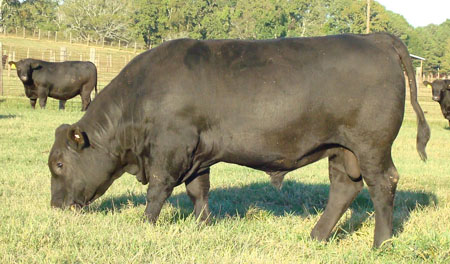
The number of cows per bull will vary with the bull's age, condition and libido. Use an adequate number of bulls with good libidos. Bulls should be in good body condition, but not fat, at the beginning of the breeding season. Young, growing bulls may require extra feed during the breeding season to meet their protein and energy needs. A yearling bull should not be expected to breed more than 20 to 25 cows, while a mature bull with good libido can breed 25 to 40, or more.
Summary
With increasing input costs, you need at least an 85 percent calf crop to realize a return on investment. You can achieve this goal by:
- shortening the calving season to between 45 and 60 days,
- providing supplements only during critical periods,
- keeping the herd healthy, and
- always following sound management practices.
By following the production practices outlined in this publication, you can make a goal of a 95-plus percent calf crop during a 45-day calving season with a 600-pound average weaning weight a reality.
Status and Revision History
Published on Feb 01, 1995
In Review on Feb 03, 2009
Published with Major Revisions on Aug 28, 2009
Published with Minor Revisions on Jun 19, 2012
Published with Full Review on Mar 31, 2017


























































